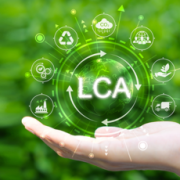Understanding Life Cycle Assessment, by Sebastián Ospina, Sustainability Engineer at Blue Synergy
Written by Sebastián Ospina Corral – Sustainability Engineer at Blue Synergy SL.
In Blue Synergy, life cycle assessment (LCA) is one of our core services. Our sustainability engineers have addressed LCA studies in a wide range of sectors including bio-based industries, biotechnology, nanoelectronics, food sector, remediation, biowaste revalorization, among others. Today we want to share with you, in simple terms, what is LCA and the importance of it when developing new sustainable technologies and products.
Many everyday items, from a cotton t-shirt to a smartphone, have a secret environmental story. While we might focus on an item’s immediate use or disposal, the most significant impacts—such as the massive water consumption to grow cotton or the high carbon emissions from manufacturing electronics—often occur long before a product reaches us. This hidden “environmental footprint,” embedded in complex global supply chains, makes it difficult to judge what is truly sustainable. Life Cycle Assessment (LCA) is the scientific method designed to uncover this complete story and measure a product’s true impact from beginning to end.
An LCA acts like an “environmental detective,” systematically analysing a product’s entire journey from “cradle-to-grave.” This process is broken down into five key stages: Raw Material Extraction, where resources are taken from the earth; Manufacturing, where those resources are processed and assembled; Distribution, which involves global transportation; the Use Phase, covering how a consumer uses and maintains the product; and finally, the End-of-Life, which deals with disposal, recycling, or reuse. By quantifying the energy, water, and emissions at each stage, an LCA can identify the biggest environmental “hotspots.”
The credibility of any LCA depends heavily on two factors: the quality of its data and the scope of its analysis. The data must be accurate, representative of real-world conditions, and complete. Just as important are the “system boundaries,” which define what is included in the study. A “cradle-to-gate” assessment, for example, only measures impact up to the factory exit, ignoring the significant effects of consumer use and disposal. In contrast, a full “cradle-to-grave” assessment provides a more honest and comprehensive picture, preventing a narrow focus that could hide major environmental problems.
Conducting a thorough LCA is not without its challenges. Analysts often face data gaps from secretive supply chains, the complex problem of allocating impacts when one factory produces multiple products, and the high cost and time required for a detailed study. Unfortunately, these complexities can be exploited for “greenwashing,” where companies make misleading environmental claims by cherry-picking favourable data, using narrow system boundaries, or reporting selectively to hide negative impacts. This makes third-party verification and transparency crucial for building trust.
Ultimately, the goal of an LCA is not just to measure impact but to drive positive change. By identifying environmental hotspots, LCAs provide a clear roadmap for engineers and designers to innovate, leading to more sustainable products, as seen in examples from the apparel and automotive industries. This scientific foundation also empowers policymakers to create effective environmental regulations and helps build consumer trust through transparent, credible labels. By making the invisible visible, LCAs enable both industries and individuals to make smarter, more sustainable choices.



